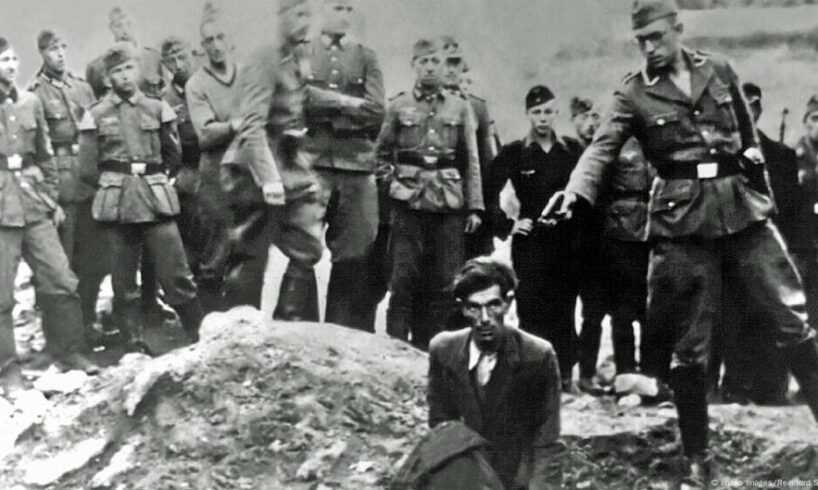
A man in a long coat with a full head of hair and sunken cheeks, kneels at the edge of a mass grave, resigned to his fate.
The dozens of corpses below him and the gunman pointing a pistol to the back of his head leave no room for doubt — he knows his life is about to end. The victim’s identity remains a mystery, but a match has been found for the perpetrator with 99% certainty.
The gunman in the photo, striking a “casual pose,” while showing “performative indifference” and “procedural matter-of-factness,” is most likely Nazi war criminal Jakobus Onnen, and the photo was probably a Nazi trophy, explains German historian Jürgen Matthäus.
The victim, however, could not be identified
The latest findings by the former head of the United States Holocaust Memorial Museum’s research department recently appeared in the Zeitschrift für Geschichtswissenschaft (or “Journal of Historical Science”), published by Metropol Verlag.
“This is a massive step forward in getting to the historical reality of the Holocaust. These are the moments where — if I can generalize — where historians are really thinking, ‘Aha, here I’ve really pushed the limit of what we know’,” Matthäus told DW.
This photo became one of the most famous images of the Holocaust, titled “The Last Jew in Vinnitsa.” It first drew attention in 1961, during the trial of Nazi war criminal Adolf Eichmann in Israel. However, little was known about the image until now, and some of what was known turned out to be incorrect in retrospect.
Though titled ‘The Last Jew in Vinnitsa,’ research has revealed that the crime happened in Berdychiv, about 150 km from KyivImage: USHMM-Archiv 2021.159.
The photo’s history
According to the United Press International (UPI) news agency, which distributed the photo at the time, it was supplied by Al Moss, a Holocaust survivor from Chicago. He reportedly received the photo in Munich in 1945 shortly after his liberation by American troops and handed it over to UPI.
But the image had long been mislabeled. Only in 2023 did Matthäus discover that the photo wasn’t taken some time between 1941 and 1943 in the Ukrainian city of Vinnytsia as originally thought, but rather in Berdychiv, about 150 km from Kyiv.
The error was discovered through a stroke of serendipity. A few years ago, the United States Holocaust Memorial Museum in Washington D.C. received the war diaries of Austrian Wehrmacht soldier Walter Materna, who was stationed in Berdychiv in 1941.
They included a print of this photo, but of significantly better quality than the previously known copy. On the back was written, “Late July 1941. Execution of Jews by the SS in the citadel of Berdychiv. July 28, 1941.”
A diary entry by Materna on the same date, in which he describes the murder of hundreds of Jewish people at the same pit at the Berdychiv citadel, reinforced the theory that the crime scene was not Vinnytsia, but Berdychiv.
Matthäus published the results of his research on Materna’s diaries in late 2023 in the journal “Holocaust and Genocide Studies.” The German daily WELT reported on the topic.
By comparing current and historical images, Berdychiv was identified as the scene of the crimeImage: METROPOL VERLAG
Successful use of hive minds
Jürgen Matthäus then received several tips from readers who claimed to have recognized the perpetrator. One of them came from a retired high school teacher who wrote that the “horrifying image” had played a role in his family for decades “because it shows an SS member who resembles an uncle of my wife, her mother’s brother… An uncle who was ‘on site’ as a member of Einsatzgruppe C during the period in question,” Matthäus wrote in the Journal of Historical Science.
This ‘uncle’ was Jakobus Onnen, who was born into a middle-class family in 1906 in the East Frisian village of Tichelwarf, near the Dutch border. He studied French, English and sports in Göttingen to become a teacher, following in his late father’s footsteps. He later taught at the German Colonial School in Witzenhausen.
In 1931, he joined the Sturmabteilung (or SA), a paramilitary organization of the Nazi Party and a year later he transferred to the SS, a kind of elite police force under the Nazis that had started out as Adolf Hitler’s personal bodyguard. In early June 1941, he became part of Einsatzgruppe C, which murdered hundreds of thousands of Jewish people in Eastern Europe.
“He joined the SA and then later the SS. His study time in Göttingen was clearly influenced by the Nazi student movement, which was very strong, particularly in Göttingen at the time. So here is the Nazification that you can observe,” Matthäus says.
‘AI was the icing on the cake’
Onnen was never investigated because he died in battle in August 1943. In addition, his sister had destroyed a collection of letters he’d sent her, eliminating the possibility of using them to reconstruct events.
The perpetrator was identified using facial recognition software
Despite such hurdles, AI experts pitched in and managed to determine the murderer’s identity using AI-based facial recognition software with a high degree of certainty. This feat was achieved largely through the help of the high school teacher who recognized his relative in the image and sent photos to use for comparison.
“The more we cooperate across the disciplinary divide, which is not a given particularly in the humanities, the better. This is very much collaborative … Holocaust studies exist only as an interdisciplinary field,” say Matthäus, adding that such collaborations could also involve art historians, technical experts, musicologists, psychologists and political scientists among others.
Victims remain unidentified
The name and biographical details of the shooter are now known. Yet the victim remains unknown — as in so many cases — even though his face is clearly visible in the photograph. This is not surprising, says Matthäus, because the Nazis deliberately did not list the names of the people shot in Eastern Europe — unlike in the case of deportations from Western Europe.
“Increasingly over time, there have been massive efforts to de-anonymize the victims by identifying them by name. Who were these people? A lot of this work was done by survivors who stepped forward and identified on the basis of photos or memoirs and testimonies like at the Shoah Foundation at Yad Vashem and also at the US Holocaust Museum in Washington,” explains Matthäus.
Historian Jürgen Matthäus worked long to identify the people in the photo from the Holocaust periodImage: privat
Nonetheless, the historian remains “cautiously optimistic” that one day interdisciplinary collaboration, hive minds and AI will enable the victim in this photo to be identified, besides opening up many new opportunities for Holocaust research.
“If this is possible for this photo, it might be possible for letters, diaries. I think a lot hinges on the willingness of society to embrace this, not just the political class. But also individuals and families to confront this,” says Matthäus.
The article was originally published in German.





